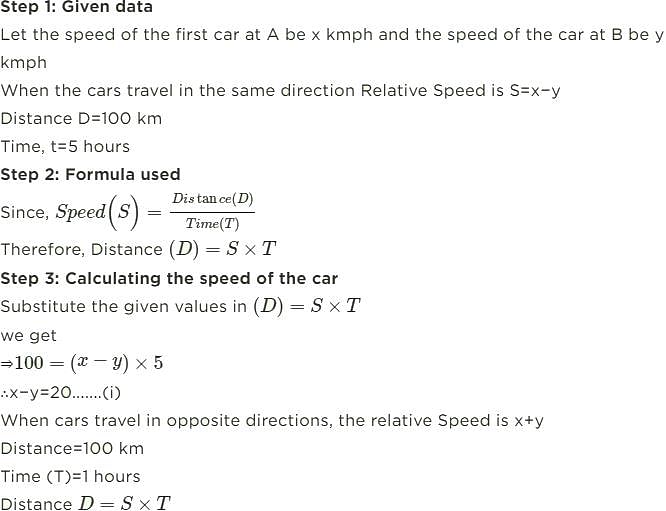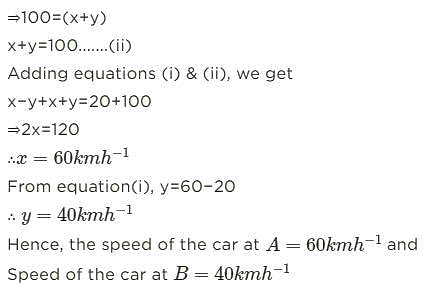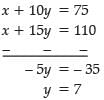Case Based Questions Test: Pair of Linear Equations in Two Variables - Class 9 MCQ
12 Questions MCQ Test - Case Based Questions Test: Pair of Linear Equations in Two Variables
Direction: Read the following text and answer the following questions on the basis of the same:
Places A and B are 100 km apart on a highway. One car starts from A and another from B at the same time. If the cars travel in the same direction at different speeds, they meet in 5 hours. If they travel towards each other, they meet in 1 hour.

The given problem is based on which mathematical concept

Direction: Read the following text and answer the following questions on the basis of the same:
Places A and B are 100 km apart on a highway. One car starts from A and another from B at the same time. If the cars travel in the same direction at different speeds, they meet in 5 hours. If they travel towards each other, they meet in 1 hour.

What is the relative speed of both cars while they are travelling towards each other ?

| 1 Crore+ students have signed up on EduRev. Have you? Download the App |
Direction: Read the following text and answer the following questions on the basis of the same:
Places A and B are 100 km apart on a highway. One car starts from A and another from B at the same time. If the cars travel in the same direction at different speeds, they meet in 5 hours. If they travel towards each other, they meet in 1 hour.

Q. What are the speeds of the two cars?

Direction: Read the following text and answer the following questions on the basis of the same:
Places A and B are 100 km apart on a highway. One car starts from A and another from B at the same time. If the cars travel in the same direction at different speeds, they meet in 5 hours. If they travel towards each other, they meet in 1 hour.

Assuming that the speed of first car and second car be u km/h and v km/h respectively.
What is the relative speed of both cars while they are travelling in the same direction ?
Direction: Read the following text and answer the following questions on the basis of the same:
Places A and B are 100 km apart on a highway. One car starts from A and another from B at the same time. If the cars travel in the same direction at different speeds, they meet in 5 hours. If they travel towards each other, they meet in 1 hour. What is the difference of speeds in Km/hr of the two cars?
Direction: Read the following text and answer the following questions on the basis of the same:
It is common that Governments revise travel fares from time to time based on various factors such as inflation (a general increase in prices and fall in the purchasing value of money) on different types of vehicles like auto, Rickshaws, taxis, Radio cab etc. The auto charges in a city comprise of a fixed charge together with the charge for the distance covered. Study the following situations.
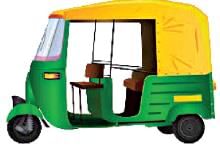
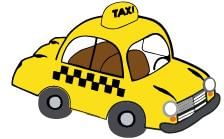

Situation 2: In a city B, for a journey of 8 km, the charge paid is ₹ 91 and for a journey of 14 km, the charge paid is ₹ 145.
The graph of lines representing the conditions are:
Direction: Read the following text and answer the following questions on the basis of the same:
It is common that Governments revise travel fares from time to time based on various factors such as inflation (a general increase in prices and fall in the purchasing value of money) on different types of vehicles like auto, Rickshaws, taxis, Radio cab etc. The auto charges in a city comprise of a fixed charge together with the charge for the distance covered. Study the following situations.
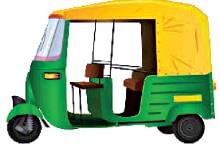


Situation 2: In a city B, for a journey of 8 km, the charge paid is ₹ 91 and for a journey of 14 km, the charge paid is ₹ 145.
What will a person have to pay for travelling a distance of 30 km?
Direction: Read the following text and answer the following questions on the basis of the same:
It is common that Governments revise travel fares from time to time based on various factors such as inflation (a general increase in prices and fall in the purchasing value of money) on different types of vehicles like auto, Rickshaws, taxis, Radio cab etc. The auto charges in a city comprise of a fixed charge together with the charge for the distance covered. Study the following situations.
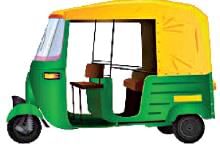
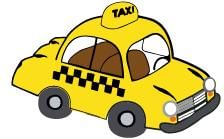

Situation 1: In city A, for a journey of 10 km, the charge paid is ₹ 75 and for a journey of 15 km, the charge paid is ₹ 110.
If the fixed charges of auto rickshaw be ₹ x and the running charges be ₹ y km/hr, the pair of linear equations representing the situation is
Direction: Read the following text and answer the following questions on the basis of the same:
It is common that Governments revise travel fares from time to time based on various factors such as inflation (a general increase in prices and fall in the purchasing value of money) on different types of vehicles like auto, Rickshaws, taxis, Radio cab etc. The auto charges in a city comprise of a fixed charge together with the charge for the distance covered. Study the following situations.

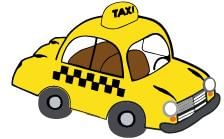

Situation 1: In city A, for a journey of 10 km, the charge paid is ₹ 75 and for a journey of 15 km, the charge paid is ₹ 110.
A person travels a distance of 50 km. The amount he has to pay is
Direction: Read the following text and answer the following questions on the basis of the same:
John and Jivanti are playing with the marbles in the playground. They together have 45 marbles and John has 15 marbles more than Jivanti.

The given problem is based on which mathematical concept ?
Direction: Read the following text and answer the following questions on the basis of the same:
John and Jivanti are playing with the marbles in the playground. They together have 45 marbles and John has 15 marbles more than Jivanti.

The number of marbles John had:
John and Jivanti together have 45 marbles. Both of them lost 5 marbles each, and the product of the number of marbles they now have is 124. From the quadratic equation to find how many marbles they had to start with, if John had x marbles.


